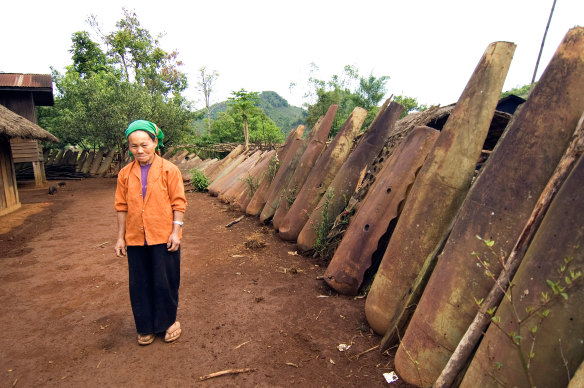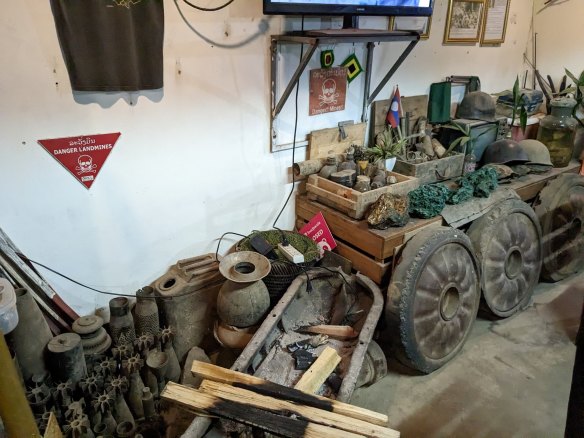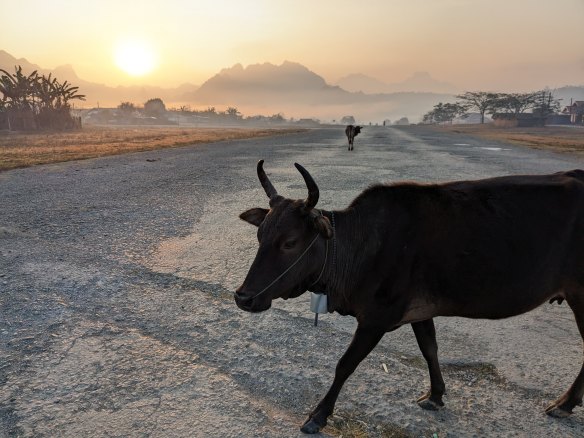This was published 2 years ago
Inside the town the CIA dubbed ‘the most secret place on Earth’
By Kurt Johnson
Historical places are often anticlimactic to visit. Expecting they will maintain their resonance indefinitely, you arrive to find the concrete and flaking paint strangely mute. This is why most have museums – to do the talking. Yet some places wear their history indelibly.
One such place is Long Tieng. Known within the CIA as “the most secret place on Earth”, a slew of swashbuckling declassified Cold War tales emerged from when the site became Lima Site 20A. From this runway the US conducted its Secret War against the Viet Cong and Pathet Lao in an effort to ‘stem the tide of communism’.

A fence made from US cluster-bomb casings.Credit: Alamy
This was done with the ‘Ravens’, US Airmen who crammed themselves into single-prop spotter planes to direct bombers. Both planes and pilots were stripped of identification, posing as private contractors to maintain the fiction of Laos’ neutrality.
Long Tieng grew into a wild frontier town, characterised by cowboy shenanigans made famous in Hollywood renditions like Air America. The local bar called the Hooch had a caged bear named Floyd. Floyd drank beer and after a heavy night would retreat hungover into his cave.
Getting to Long Tieng is not simple nor easy. I hire a motorbike in Luang Prabang and spend a day riding to the city of Phonsavan. I visit the Mines Advisory Group Visitor Information Centre. The small exhibition includes an array of bombs dropped on Laos ranging from anti-tank mines to cluster bombs. A timelapse of a map of Laos shows a single dot for each of the 600,000 bombing runs. The pockmarking becomes so dense the map is soon shaded. Laos is per-capita the most bombed country in the world.

Bombs dropped on Laos range from anti-tank mines to cluster bombs.Credit: Kurt Johnson
This exhibition instantly wipes off the Hollywood sheen. It clearly states the evils of an illegal war in which civilians were often on the receiving end of the bombs directed from Long Tieng. That 30 per cent of the bombs never exploded means Laos still lives with the legacy of so much ordnance that it hampers its development as a nation.
Back on the road the bitumen becomes a tricky mix of sharp rock and a cottony layer of dust that cloaks the deep crevices. In the wet season this must be impassible slush. After some near spills the trail evens out, dirt but well graded. Instead of gripping the handlebars for dear life I can now admire the landscape, which is utterly stunning: sierras of jungle-covered limestone karst peaks layered over the horizon to infinity.
It is late afternoon when I arrive and the sun is setting on the runway, nestled along the floor of the valley. Where once Long Tieng lived beside the runway, now much of the town lives on it. A volleyball game is going, couples take walks, cows amble, goats gambol, the former military structure is a place of casual recreation.

Credit: Kurt Johnson
The next day I find a guide called Dim who lets me visit inside General Vang Pao’s house. The General worked very closely with the Ravens who called him “VP”. He led the Hmong, an ethnic minority, who did most of the ground fighting against the Viet Cong and Pathet Lao. When defeat was imminent and Long Tieng was surrounded, VP was evacuated together with thousands of Hmong, but most were left to their fate. Mortaring of the runway began as soon as the last US plane left. VP landed in the US from where he tried to conduct a clandestine insurgency that put him in gaol till his death.
In this house briefings and strategies were conducted. It is a stout modernist structure, as solid as a bunker. In the foyer is a store of rusting ordnance: bombs, mines and rocket casings. Dim shows me through. Rooms were taken over by the Lao military after VP left. Some still have mattresses on the floor. Apart from this, all furniture and adornments have been stripped as if expecting new owners.
Suddenly music is blaring from outside. Dim and I climb to the roof. “Helicopters landed here”, she explains. Next door a traditional Hmong wedding procession of well-dressed whooping guests makes its way toward a marquee. Life goes on and for some Hmong the war continued too. As late as last year there were unconfirmed reports that Hmong rebels were still attacking Lao troops. Long Tieng has only been open to tourists since 2013.
Early next morning I ride to the runway for one last look. It’s vacant and dips down into the morning mist. Turning off my engine, I hear the distant hum of a plane overhead – a commercial jumbo probably loaded with holidaymakers. As the plane crosses overhead, the runway’s aspect aligns skyward, restoring to this place its full and complicated resonance.
DETAILS
Getting there
The closest international airport is Luang Prabang. There you can hire 250cc motorcycles – a rarity in Laos – from Lao Adv Tours for USD$50/day. Owner Chris can also provide gear, direction and assurance the roads are not as dangerous as you think, though you’ll need to be a decent motorcycle rider with some off-road experience. He also offers multi-day group motorcycle trips to Long Tieng. Check your travel insurance for travelling by motorcycle. laoadvtours.com
A less scenic option is to fly to Phonsavan from Luang Prabang. Tour agencies can provide transport and a guide.
The writer travelled with assistance from Lao Adv Tours.
Sign up for the Traveller Deals newsletter
Get exclusive travel deals delivered straight to your inbox. Sign up now.